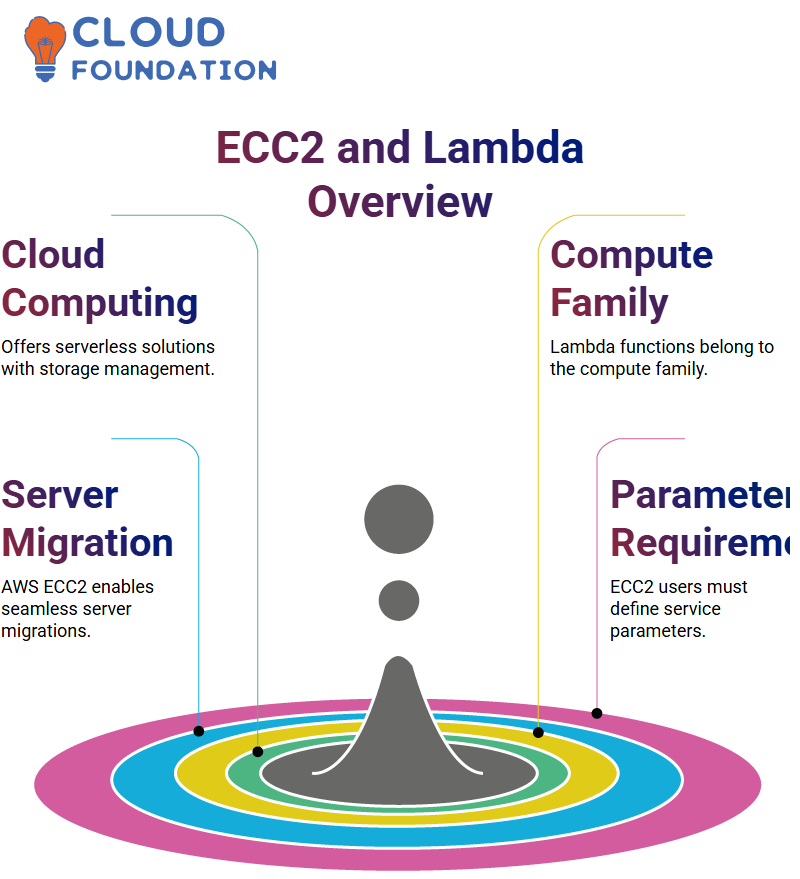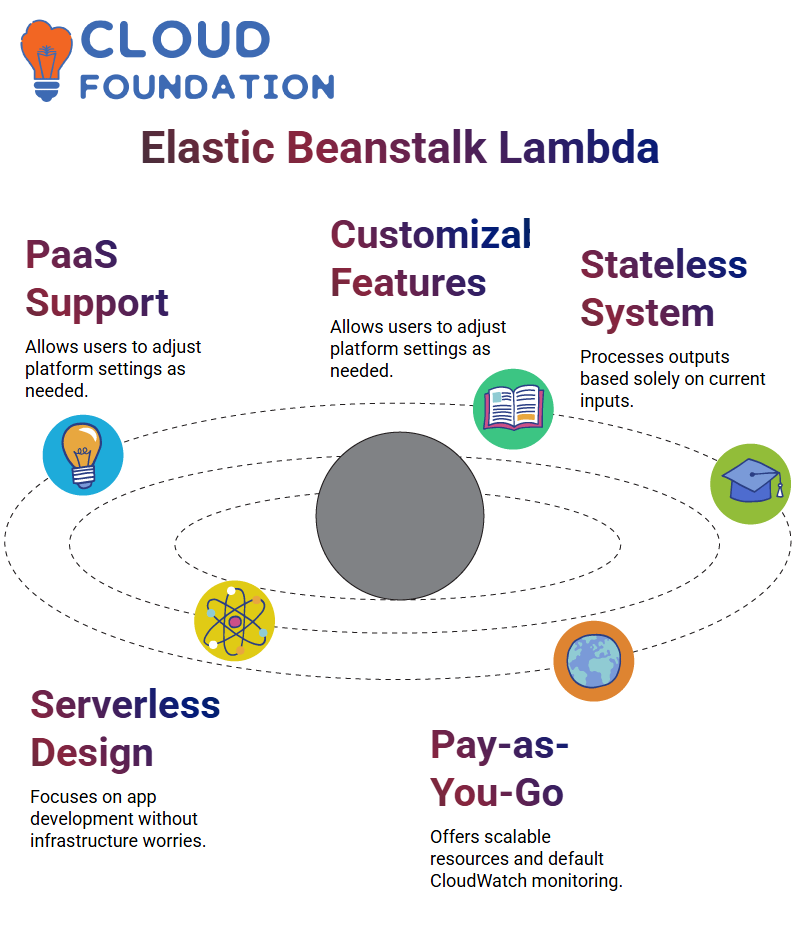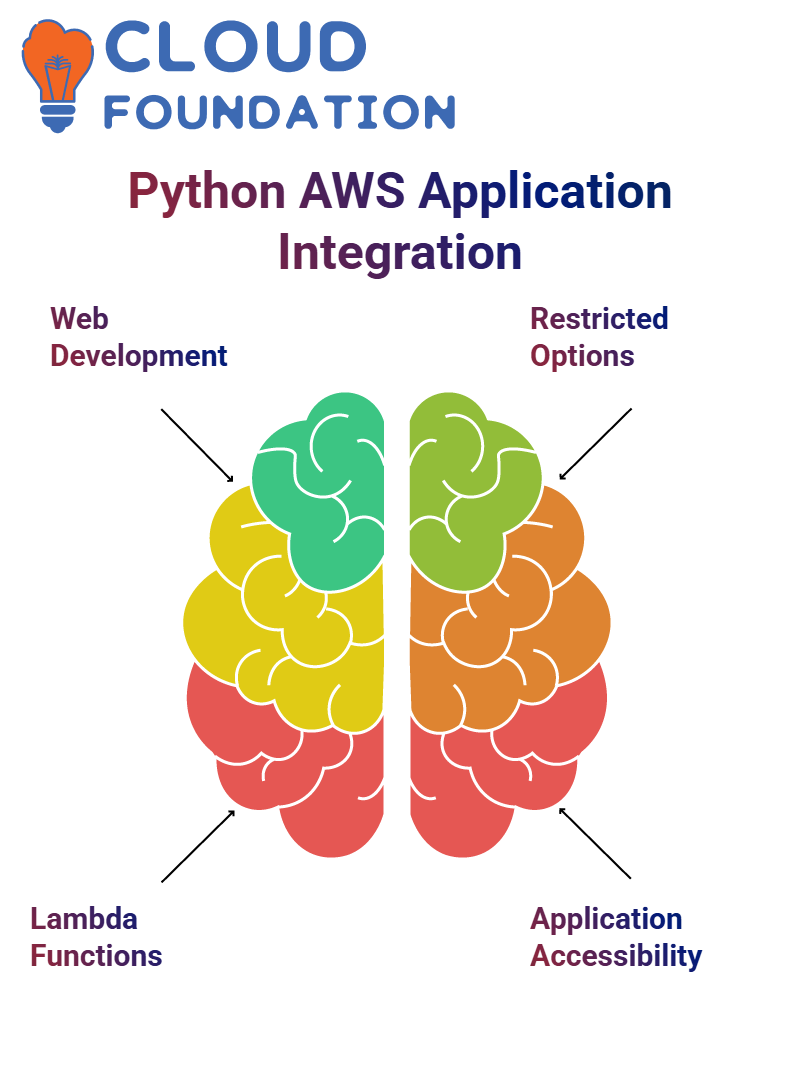What is AWS Lambda
Managing data uploads in a variety of forms is one of the most important applications for AWS Lambda, which is especially valuable in the corporate sector. When an object is uploaded to an S3 bucket in a format that is not anticipated, for instance, AWS Lambda is triggered to process the file and convert it into a thumbnail. This is done in order to reduce the size of the item.
Users are able to operate or administer any server without having to worry about provisioning when they utilize AWS Lambda, which is one of the servers that comes within the compute category. Because of this, customers are able to concentrate on the performance of their application while avoiding the complexity of provisioning and administering many services.
Features of AWS Lambda
When it comes to automatically backing up data that is stored in cloud storage, Lambda is especially beneficial.
Writing code and uploading it to Lambda, which then automatically executes the code without needing any provisioning or administration, is made possible by this mechanism.
This indicates that there is no need for the provisioning or management of servers, since Lambda will handle everything else.
Lambda is able to scale an application by executing code in response to each trigger, that code is executed in parallel, and that each trigger is processed in parallel.
It is able to scale exactly in accordance with the magnitude of the demand, which guarantees that the application will operate well.
Functions of AWS Lambda
When it comes to processing and converting data from a wide variety of devices into a variety of forms, the Lambda programming language is an extremely powerful tool.
It is possible to use it to analyze data from social media platforms, such as trending hashtag data, which is then processed and transformed into thumbnails.
The Lambda function operates in a straightforward and unobtrusive manner, and the actions that take place behind the scenes also function in a straightforward and fluid manner.

A system known as Lambda is one that takes in requests and executes them on a certain number of data containers, the number of which is determined by the amount of data being processed. It is the container that is responsible for handling the requests, and it is the container that stores the code that the user has supplied in order to fulfill the query.
Not only does containerized software separate itself from its surrounding environment, but it also ensures that it will always operate in the same manner regardless of the context in which it is being executed. This helps to reduce the likelihood of teams running different software on the same infrastructure being isolated from one another and causing conflict.
Elastic Beanstalk in AWS Lambda
Elastic Beanstalk is an infrastructure, while Lambda is a platform as a service (PaaS) that offers a platform to run and execute back-end code. Lambda is a PaaS. A limited number of programming languages, including Python, Java, C, and Sharp, are supported by Lambda.
However, customers are able to install whatever software they like on the platform that is provided to them.
On the other hand, it does not provide the luxury of selecting poles and one X, but it does enable users to individually adjust every feature, including a variety of instant kinds and their own level of protection.
Elastic Beanstalk is able to run your full application without you having to worry about the infrastructure, while Lambda can simply run you back in code. In contrast to Elastic Beanstalk, which gives you the ability to choose the instant type and other options, it also offers resources that are determined by the amount of work you are doing.

Because Elastic Beanstalk is a stateless system, its output is determined only by the inputs that are now being used; it does not take into account any other inputs. Consequently, Lambda is able to generate millions of process threads and concurrently run the model with a variety of inputs with this configuration.
The serverless design of Lambda is the primary advantage of using this platform. This architecture enables users to concentrate on developing and executing apps. They are able to choose a language, write code, and then press the “on” button to select an ECS instance that is suitable for the amount of processing power that is necessary.
There are also numerous programming runtimes and editors available with Lambda, there is no need to construct and setup ECS virtual machines, there is a pay-as-you-go PaaS capability, and there is a default monitoring option that is coupled with CloudWatch.
Limitations of AWS Lambda
AWS Lambda is a service that offers a variety of benefits, one of which is the capability to write code in a programming language that is supported, to execute functions on your behalf, and to run the code.
Amazon Web Services Lambda does, however, have certain restrictions. The first constraint is that the maximum disk space that is available for the runtime environment is less than 12 megabytes. This means that the /tmp direct storage can only hold 512 megabytes at the same time.
The amount of memory that is accessible for lambda when it is being executed ranges from 128 to 3008 megabytes, with a 64 megabyte increment between 128 and 3008. This is the second constraint it has.
The function timeout is set at 900 seconds, with a maximum of 15 minutes and a minimum of 3 seconds. This is the third constraint that is considered to be a limitation. For the fourth constraint, the only languages that may be used to write code in the lambda editor are the ones that are immediately accessible.
It is necessary to trigger the lambda function correctly in order to execute the code. This may be accomplished by using an external AWS service, such as a database or an S3 bucket from Amazon Web Services.
Lambda function in AWS S3
In the event that a write action takes place in the database, the lambda function will be automatically activated, and the code will obtain the information that is required.
On the other hand, Lambda functions come with a variety of colds that may be used for a variety of purposes, including applications that demand considerable processing power and DRAM or those that require minimal execution time.
A script or program that executes in AWS lambda when it is called is referred to as a function. In the function, the code that is utilized is referred to as the function name. The lambda runtime is responsible for carrying out the function. Additionally, the tags are key-value pairs that may be used to keep track of prices or metrics. The handler is the location where the name of the function is specified together with the name of the file.
In order to initiate a process inside the S3 bucket, the lambda function that is available in AWS S3 is used. Whenever a user visits a website with the intention of uploading images, the photo that is posted is saved in the S3 bucket.
In the event that an output action takes place, such as a put operation or a gate operation, the lambda function is activated.

Use the lambda function to either transfer the file into another S3 bucket or save the file name and location. Both of these options are available to you.
In the event that a get function causes the lambda function to be triggered when a user downloads a picture, the photo will be downloaded from the S3 bucket, which is where it is kept. This enables the establishment of a micro-service that is derived from the Lambda function.
When it comes to practical applications, the process of generating an S3 bucket and using a lambda function to transfer a file to multiple S3 buckets is accomplished by using two distinct file extensions. An image file, for instance, is sent to a separate bucket than a PDF file, which is also transferred to a different bucket.
Through the use of the S3 buckets uploading trigger, which is configured to be either as or post, the lambda code will be performed. The lambda function will be activated in a short amount of time whenever an item is posted to the shared storage bucket.
The concept of EC2 in Lambda
Lambda is a cloud computing service that offers a solution to the issue of limited storage space on Amazon Web Services (AWS). Serverless computing and computing are the two key qualities that it has. It is a member of the compute family.
Lambda functions are a member of the same family as EC2, which is another service brought up on the third day of the discussion.
In the past, individuals would construct their very own servers and then operate on those servers while they were working on data centers.

After moving to Amazon Web Services (AWS), individuals were given an option from AWS known as EC2. In order to make advantage of this service, which was known as EC2, customers were needed to provide it with a number of parameters.
It was common practice for individuals to build their own servers and operate on them. Applications were stored in data centers.
It was vital for users to have a thorough understanding of the capabilities and needs of the many services that EC2 provided, which included storage, compute, and storage, among others.
Applications in Lambda AWS
Users are able to construct and manage compute instances for their applications via the usage of Amazon Web Services (AWS), which utilizes cloud computing.
The full computing environment is created for the user by Amazon Web Services (AWS) while an application is running, and after the program is finished, it will destroy the machine.
When compared to the situation with EC2, in which the user is responsible for breaking down the instance, this is a different situation.
Within the framework of serverless architecture, users are not accountable for either the design or the server machine itself. EC2 does not need them to administer the instance; rather, Amazon Web Services is responsible for doing so.
The user is required to exert less effort and need less effort overall as a result of this. Nevertheless, in contrast to Lambda, customers are not required to explicitly declare the requirements for their applications while using this platform.
With Amazon Web Services (AWS), a compute instance may be automatically created for the customer depending on their needs, which may include a certain CPU or RAM.
In the event that the program needs more computing than it has produced, it will automatically scale up or scale down accordingly. Following the completion of the job, Amazon Web Services will automatically scale up again.
After the program has been executed, it will automatically shut down the computer after the function has been finished.
When compared to the situation with EC2, where the user is not responsible for the architecture of the server, there is a significant difference.
Through the usage of EC2, users are able to create and destroy instances without having to manage them. When it comes to serverless architecture, on the other hand, the server is not accountable for the architecture, and the user is not accountable for the server itself.
Amazon Web Services (AWS) is responsible for administering the instance in both scenarios, which decreases the amount of work that is necessary to operate the application.
The comparison between Amazon Web Services (AWS) and Lambda reveals that AWS offers services that are more effective and dependable than those offered by other cloud computing platforms.
The serverless design makes it possible to administer the application with more flexibility, which in turn reduces the amount of responsibility that users have to take on for maintaining their own infrastructure
Python is generally used for the development of web applications, and it is compatible with Java. In addition to being a popular option for the construction of web applications, Ruby is also a popular option for developers.
You are only able to type in a limited number of choices as a DevOps engineer, and these options might be restricted by the programming languages that you do utilize.
Python is an example of a language that can be used in a variety of ways so that applications may be written. In the Amazon Web Services environment, for instance, you may build a Lambda function and then activate it by selecting an option that is referred to as “enable function URL.
” By doing so, you will be able to access the application from a location that is not part of the AWS environment.
The application cannot be accessed from a location that is not part of the Amazon Web Services environment if you do not activate this option.
However, you are still able to execute the software inside the Amazon Web Services environment.
The trigger and the destination are the two choices that may be used in the process of creating the function. Even though it is not required, the trigger is used the majority of the time.

Gayathri
Author




